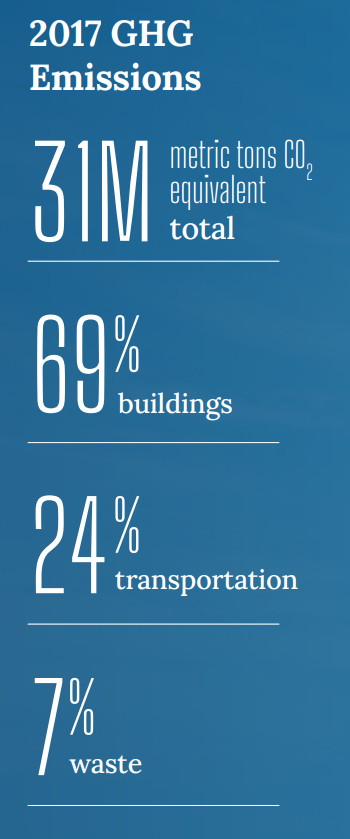Electrify Chicago
An independent tool for viewing City of Chicago building data
According to the
2022 Chicago Climate Action Plan,
69% of Chicago's emissions come from buildings, making
building emissions our biggest challenge and our biggest opportunity as a city
to tackle climate change. At Electrify Chicago, we showcase building performance using
publicly available data supplemented by community-submitted photographs and building
owners.
Start by looking at Chicago's buildings with the highest greenhouse gas intensity i.e. emissions per square foot. Large, efficient, buildings can perform much better than very inefficient small buildings on this metric.
New Article
📰 $30 Million In Missed Fines
The City Of Chicago failed to collect $30 million in potential fines from the building benchmarking ordinance, reducing transparency and accountability.
Legislative update! 🎉
As of late January 2024, legislation is being introduced to require new use more efficient forms of water and space heating, via the Clean And Affordable Buildings Ordinance (CABO), which will reduce the number of highly polluting and inefficient buildings that end up on this site.
If you're in Chicago,
write to your alderman to support the CABO!
Chicago Buildings by Greenhouse Gas Intensity
Note: Data includes large Chicago buildings with data from 2022, unless explicitly stated otherwise.
Note: This data only includes buildings whose emissions are reported
under the
Chicago Energy Benchmarking Ordinance. According to the City “As of 2016,
this list includes all commercial, institutional, and residential buildings larger than
50,000 square feet.” This dataset is also then filtered to only buildings with
reported emissions > 1,000 metric tons CO2 equivalent.
The latest year of data is from 2022, but we update the site regularly when new data is available, and some buildings may have failed to report that year, and only have older data available.
| Property Name / address | Primary Property Type |
Greenhouse Gas Intensity (kg CO2 eq./sqft) |
Total Greenhouse Emissions (metric tons CO2 eq.) |
|---|---|---|---|
|
Axis Apartments & Lofts
441 E Erie St
| Multifamily Housing | 11.3 kg/sqft
Highest 10%
| 6,474 tons
Highest 5%
|
|
1111 N Clark St
1111 N Clark St
| Vehicle Dealership | 11.3 kg/sqft
Highest 10%
| 1,017 tons
Highest 44%
|
|
Claretian Missionaries Service
🕰️
205 W. Monroe
| Worship Facility | 11.3 kg/sqft | 1,223 tons |
|
Quality Inn Midway Airport
🕰️
7353 S CICERO AVE
| Hotel | 11.3 kg/sqft | 983 tons |
|
Lake Meadows Shopping Center Building 2
3445 3481 S King Dr
| Fitness Center/Health Club/Gym | 11.2 kg/sqft
Highest 10%
| 675 tons
Lowest 39%
|
|
Gateway Chicago West
3828 W Taylor St
| Residential Care Facility | 11.2 kg/sqft
Highest 10%
| 575 tons
Lowest 32%
|
|
BAI Century, LLC
2828 N Clark St
| Enclosed Mall | 11.2 kg/sqft
Highest 10%
| 1,954 tons
Highest 24%
|
|
840 N Michigan Ave
840 N Michigan Ave
| Retail Store | 11.2 kg/sqft
Highest 10%
| 973 tons
Highest 46%
|
|
Gunsaulus Hall
🕰️
(Illinois Tech)
3140 S Michigan Avenue
| Residence Hall/Dormitory | 11.1 kg/sqft | 924 tons |
|
908 920 W ARGYLE ST
908 920 W ARGYLE ST
| Senior Living Community | 11.1 kg/sqft
Highest 10%
| 1,637 tons
Highest 29%
|
|
City North 14
2600 N Western Ave
| Movie Theater | 11.1 kg/sqft
Highest 10%
| 809 tons
Lowest 47%
|
|
30 W OAK ST
30 W OAK ST
| Multifamily Housing | 11.1 kg/sqft
Highest 10%
| 1,985 tons
Highest 23%
|
|
Charles M. Harper Cetner (Booth School)
(UChicago)
5807 S Woodlawn Ave
| College/University | 11.1 kg/sqft
Highest 10%
| 4,640 tons
Highest 7%
|
|
CW GLL 444 N Michigan
444 N Michigan Ave
| Office | 11.1 kg/sqft
Highest 10%
| 5,746 tons
Highest 6%
|
|
300 E Randolph
🕰️
300 E Randolph
| Office | 11.1 kg/sqft | 24,655 tons |
Data Source:
Chicago Energy Benchmarking Data
